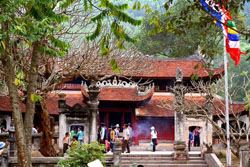A serene, almost sacred, atmosphere envelops the mountainous scenery of Ve Linh commune in Soc Son district, 30km north of Hanoi’s centre, where legend has it Saint Giong flew back to heaven on his horse after defeating foreign invaders.
Colour abounds in the area, turquoise blue lakes – believed to be the footprints of Saint Giong’s horse – contrast against the palate of green mountains, hills and trees that mingle softly with the local bamboo, said to be coloured yellow from fire from Saint Giong’s horse; while stones intersperse the soft colours, giving the look of a painting.
An eco-tourism complex is planned for this most historic of places, covering 270 ha, and will include a golf course if you have had your fill of history.

Nguyen Van Lam, director of the Soc Temple Tourism and Relics Management said the area attracts around 15,000 visitors per year.
At the centre of the planned tourism project is Soc Temple, one feels free from the hustle and bustle of city life, and you can almost hear history calling in the wind.
The temple complex was built in the pre-Le Dynasty (980), and has altars to worship Saint Giong, his mother, and local gods and goddesses. It was recognised as a national historic relic in 1962 and was last restored in 1992.
The most important feature of the temple buildings is the main altar, made from a mixture of clay, sugarcane juice, paper and lime. It is unique in Vietnam and forms the shape of the mountain ranges surrounding the complex. Seven statues are worshipped at the temple. The statues are standing, a rare sight in Vietnam as Nguyen Vu Dai, a temple guard, explains, “Standing statues are quite rare as most of local temples worship sitting statues.â€
The back of the altar opens into a cave that can be explored if you enter from the left and exit from right.
“Going from left to right symbolises going in by the father gate and out by the mother gate,†said Dai, “the cave represents the resting place of all Vietnamese ancestors.â€
Stopping in the middle of the cave and looking towards the statue of Saint Giong, visitors should take a deep breath to receive the holy air from the back of the statue.
“You will get the strength of Saint Giong and live longer,†Dai said.
Mid way up Hon Da Trong Mountain there is a big white stone, cleft in two, that locals believe is Saint Giong’s armour. A statue of Saint Giong will be placed at the mountain peak in time for the 1,000th anniversary of the founding of Thang Long-Hanoi in 2010.
“I have chosen an image of an 18-year-old boy with strong arms and legs for the statue,†said sculptor Nguyen Kim Xuan, the creator of Giong’s statue, “As there is no model for the heroic figure, the statue should symbolise the strength of Vietnamese people to maintain peace and wipe out invaders.â€
The finished work will be 40m tall and weigh 50 tons.